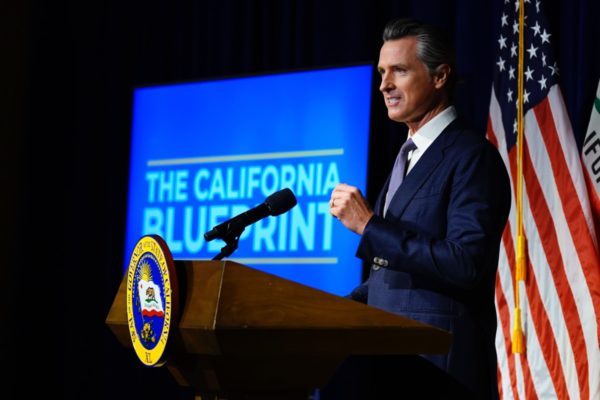

California Gov. Gavin Newsom unveils his proposed 2022-2023 state budget during a news conference in Sacramento, Calif., Monday, January 10, 2022. (AP Photo/Rich Pedroncelli)
By ADAM BEAM, Associated Press
SACRAMENTO, Calif. (AP) — Backed by soaring revenues amid the pandemic, California Gov. Gavin Newsom on Monday proposed a budget that would pay for the health care of all the state’s low-income residents living in the country illegally, while cutting taxes for businesses and halting a scheduled increase in the gas tax later this summer.
California taxpayers already pay for the health care of young adults and people 50 and over living in the country illegally, provided they meet certain income requirements. Now, Newsom wants California to become the first state to cover all adults who are living in the country illegally, a move that would eventually cost $2.2 billion per year.
“We’re doing something that no other state has done,” Newsom said.
Newsom said his $286.4 billion budget proposal tackles five of the state’s biggest problems —what his administration called “existential threats”— including the surging coronavirus pandemic; wildfires and drought worsened by global warming; homelessness; income inequality including the lack of health insurance for some immigrants; and public safety, including combatting a recent flurry of coordinated smash-and-grab robberies.
The “existential” label is usually applied to climate change and the pandemic, Newsom acknowledged, but he said homelessness, the rising cost of living, and public safety are “understandably top of mind in terms of people’s concerns.”
The governor said his budget includes a $45.7 billion surplus, which is larger than previous estimates because his administration uses a different definition of what counts as surplus.
The proposed $2.2 billion program to aid immigrants in the country illegally would not take effect until January 2024 to include “all low-income Californians, regardless of immigration status,” Newsom said.
The state has made great strides in reducing its uninsured population in recent years, but the largest single group left behind under the state’s Medicaid program are low-income residents in the country illegally.
The state began covering immigrants 26 and under in 2019, and those 50 and older last year.
The governor’s budget address kicks off months of haggling with his fellow Democrats who control the state legislature, talks that will intensify when Newsom presents an updated spending proposal in May.
Some progressive legislative Democrats last week proposed creating in California the nation’s first universal health care system, backed by steep tax hikes that would have to be approved by voters. But Newsom touted his own more incremental approach.
Among steps to ease the state’s rising costs, he proposed pausing a scheduled increase to the state’s gas tax on July 1. It was one of 10 tax incentives he touted. He also proposed $45 million to promote tourism; $40 million to waive filing fees for new businesses; and $26 million to provide technical assistance to new businesses
Newsom also has pledged to spend $300 million on boosting law enforcement efforts to combat retail theft and another $2.7 billion to spend on things like coronavirus testing and hospital staffing.
He additionally on Monday proposed spending $648 million to back wildland firefighters and buy more helicopters and bulldozers, plus another $1.2 billion on top of the current budget year’s $1.5 billion for forest management.
Another $750 million would go to drought relief, on top of the current budget year’s $5.2 billion water package.
Also on the environmental front, he pledged to keep reducing California’s reliance on fossil fuels.
“On the surface, there are certainly things to like in this proposal; funding for clean water, wildfire prevention and homelessness are all worthy goals,” Assembly Republican Leader Marie Waldron said in a statement. “But look at the details and you’ll see that much of this spending isn’t going to transformative projects to improve the lives of Californians, but rather to clean up from years of Democratic mismanagement.”
Sen. Jim Nielsen, the ranking Republican on the state Senate’s budget committee, said the state should devote its budget surplus to building reservoirs, increasing forest management to alleviate wildfires, and supporting law enforcement.
To confront the state’s seemingly intractable homelessness problem, Newsom proposed spending $2 billion for mental health services, housing, and clearing homeless encampments. That’s on top of last year’s $12 billion package. The combination would create a projected 55,000 new housing units and treatment slots.
To help with the ever-growing cost of living in California, Newsom proposed “doubling down” on the state’s existing plan to provide free universal pre-kindergarten, adding thousands of child care slots, and boosting before-, after-, and summer-school programs.
He also proposed continued aid to small businesses hit hard by the pandemic, by waiving fees and providing hundreds of millions in grants and tax breaks.
Newsom’s massive projected budget and surplus bring the state a long way from the gloom of 2020, when Newsom and state lawmakers cut spending, raised taxes, and pulled money from the state’s savings accounts to cover what they feared would be a pandemic-fueled $54 billion deficit.
That deficit never happened. Instead, state revenues soared like never before. In September, collections from the state’s three largest taxes —personal income, sales, and corporation— were 40 percent higher than September 2020 and nearly 60 percent higher than September 2019, before the pandemic hit, according to the Legislative Analyst’s Office.
___
Associated Press reporter Don Thompson contributed.



Gov Newsom should do as progressives want. implement univ healthcare for everyone so the voters can vote on steep tax increases.
the federal govt gave cali a ton of money. lets see next year